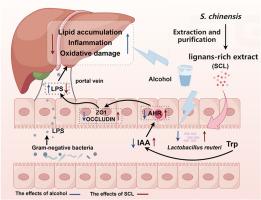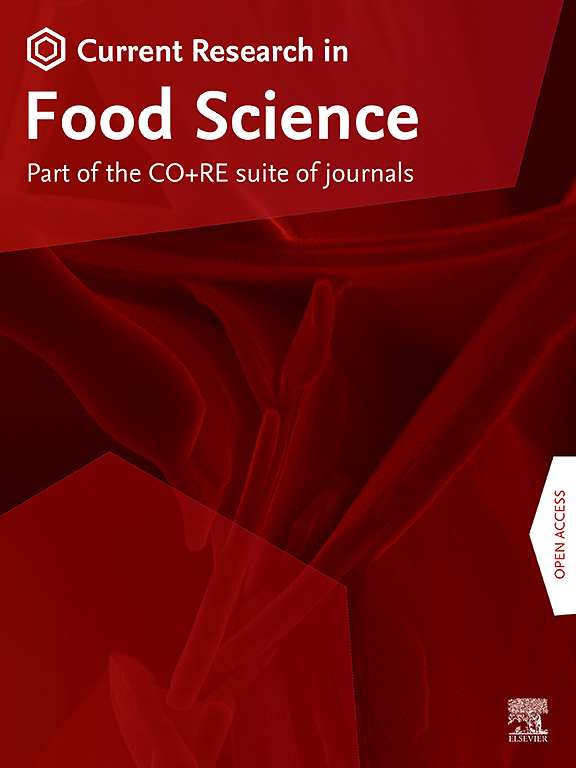五味子富含木酚素的提取物通过调节肠道微生物群和色氨酸代谢来预防酒精相关的肝脏疾病
IF 7
2区 农林科学
Q1 FOOD SCIENCE & TECHNOLOGY
引用次数: 0
摘要
酒精相关性肝病(ALD)已成为全球关注的公共卫生问题,肠道菌群在其发病机制中起着决定性作用。五味子是一种功能性食用浆果,具有保护肝脏的作用。然而,其主要活性成分木脂素对ALD的预防作用,以及它们与肠道微生物群和肠道代谢物的关系尚不清楚。本研究采用慢性酒精狂饮诱导的ALD小鼠模型,评价不同剂量的富木酚素五味子提取物(SCL)干预对肝脏的保护作用。16S rDNA测序和代谢组学分析研究了肠道内容物的微生物和代谢物谱。通过体内和体外实验进一步验证了关键代谢物对SCL的保肝活性。结果表明,SCL可有效恢复肠屏障功能,减轻酒精性肝损伤。SCL调节肠道色氨酸(Trp)代谢,恢复吲哚-3-乙酸(IAA)水平。同时,SCL重塑了肠道菌群组成,丰富了罗伊氏乳杆菌。进一步的体内和体外研究表明,scl介导的罗伊氏乳杆菌的富集有助于肠道IAA的恢复,从而重新激活乙醇抑制的AHR通路,增强肠道屏障的完整性,减少脂多糖转运进入循环,最终减轻肝损伤。总之,SCL通过调节肠道微生物群和色氨酸代谢来预防ALD。本研究为开发五味子作为预防ALD的功能性食品提供了科学依据。本文章由计算机程序翻译,如有差异,请以英文原文为准。

Lignans-rich extract of Schisandra chinensis prevent alcohol-associated liver disease by regulating the gut microbiota and tryptophan metabolism
Alcohol-associated liver disease (ALD) has emerged as a global public health concern, and gut microbiota plays a decisive role in its pathogenesis. Schisandra chinensis, a functional edible berry, exhibits hepatoprotective properties. However, the preventive effects of its main active component lignans against ALD, as well as their connections with gut microbiota and intestinal metabolites remain unclear. This study employed a mouse model of ALD induced by chronic-binge ethanol feeding to evaluate the hepatoprotective effects of lignans-rich extract of S. chinensis (SCL) interventions at different doses. 16S rDNA sequencing and metabolomic analysis were used to investigate microbial and metabolite profiles in intestinal contents. The hepatoprotective activity of key metabolite responding to SCL was further verified by in vivo and in vitro experiments. The results demonstrated that SCL effectively restored intestinal barrier function and alleviated alcohol-induced hepatic injury. SCL modulated intestinal tryptophan (Trp) metabolism and restored indole-3-acetic acid (IAA) levels. Concurrently, SCL reshaped the gut microbiota composition, enriched L. reuteri. Further in vivo and in vitro investigations demonstrated that SCL-mediated enrichment of L. reuteri contributed to intestinal IAA restoration which reactivated the ethanol-suppressed AHR pathway, enhanced intestinal barrier integrity, reduced lipopolysaccharide translocation into circulation and ultimately attenuates liver injury. Collectively, SCL prevent ALD by regulating intestinal microbiota and Trp metabolism. This study provides a scientific foundation for the development of S. chinensis as a functional food for ALD prevention.
求助全文
通过发布文献求助,成功后即可免费获取论文全文。
去求助
来源期刊

Current Research in Food Science
Agricultural and Biological Sciences-Food Science
CiteScore
7.40
自引率
3.20%
发文量
232
审稿时长
84 days
期刊介绍:
Current Research in Food Science is an international peer-reviewed journal dedicated to advancing the breadth of knowledge in the field of food science. It serves as a platform for publishing original research articles and short communications that encompass a wide array of topics, including food chemistry, physics, microbiology, nutrition, nutraceuticals, process and package engineering, materials science, food sustainability, and food security. By covering these diverse areas, the journal aims to provide a comprehensive source of the latest scientific findings and technological advancements that are shaping the future of the food industry. The journal's scope is designed to address the multidisciplinary nature of food science, reflecting its commitment to promoting innovation and ensuring the safety and quality of the food supply.
 求助内容:
求助内容: 应助结果提醒方式:
应助结果提醒方式:


